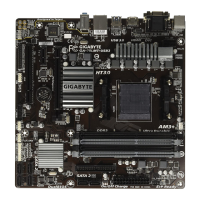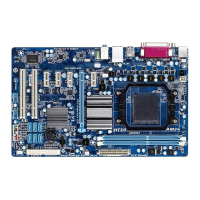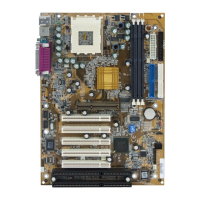
Do you have a question about the Gigabyte GA-78LMT-USB3 and is the answer not in the manual?
| Memory voltage | 1.5 V |
|---|---|
| Memory channels | Dual-channel |
| Memory slots type | DIMM |
| Number of memory slots | 4 |
| Supported memory types | DDR3-SDRAM |
| Maximum internal memory | 32 GB |
| Supported memory clock speeds | 1066, 1333 MHz |
| Processor socket | Socket AM3+ |
| Processor manufacturer | AMD |
| Compatible processor series | Athlon II |
| USB 2.0 connectors | 1 |
| Power fan connector | Yes |
| Number of SATA II connectors | 6 |
| Number of Parallel ATA connectors | - |
| USB 3.2 Gen 1 (3.1 Gen 1) connectors | 2 |
| USB 2.0 ports quantity | USB 2.0 ports have a data transmission speed of 480 Mbps, and are backwards compatible with USB 1.1 ports. You can connect all kinds of peripheral devices to them. |
| Component for | PC |
| Power source type | ATX |
| Motherboard chipset | AMD 760G |
| Audio output channels | 7.1 channels |
| Motherboard form factor | micro ATX |
| Supported storage drive interfaces | SATA II |
| Parallel processing technology support | Not supported |
| Ethernet interface type | Gigabit Ethernet |
| Width | 244 mm |
|---|
Compliance statement for FCC Part 2, Section 2.1077(a).
Diagram showing the physical arrangement of motherboard components.
Lists items included in the motherboard package.
Schematic illustrating the functional connections between motherboard components.
Essential safety and installation guidelines to prevent damage.
Detailed technical specifications of motherboard components and features.
Step-by-step guide for installing the Central Processing Unit.
Instructions for installing DDR3 memory modules into the motherboard slots.
Guide for inserting PCI Express and PCI expansion cards.
Description of ports and connections on the motherboard's rear panel.
Details on internal headers for power, fans, USB, and front panel connections.
Overview of screens displayed during the computer's boot process.
Explanation of the primary BIOS setup options and navigation.
Advanced settings for CPU, memory, and system clock adjustments.
Configuration of system date, time, and IDE/SATA device detection.
Settings for boot order, virtualization, and system performance options.
Configuration options for onboard devices like SATA, LAN, and Audio.
Settings related to ACPI sleep states, power-on options, and energy saving.
Settings for Plug and Play and PCI resource assignments.
Monitoring of system voltages, temperatures, and fan speeds.
Option to load the safest, most stable BIOS default settings.
Option to load the optimal BIOS default settings for system performance.
Setting passwords to protect BIOS access and system startup.
Saving BIOS configuration changes and exiting the setup utility.
Exiting BIOS setup without applying any changes.
Guide on installing SATA hard drives and configuring RAID arrays.











